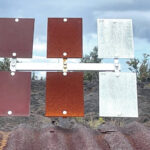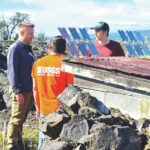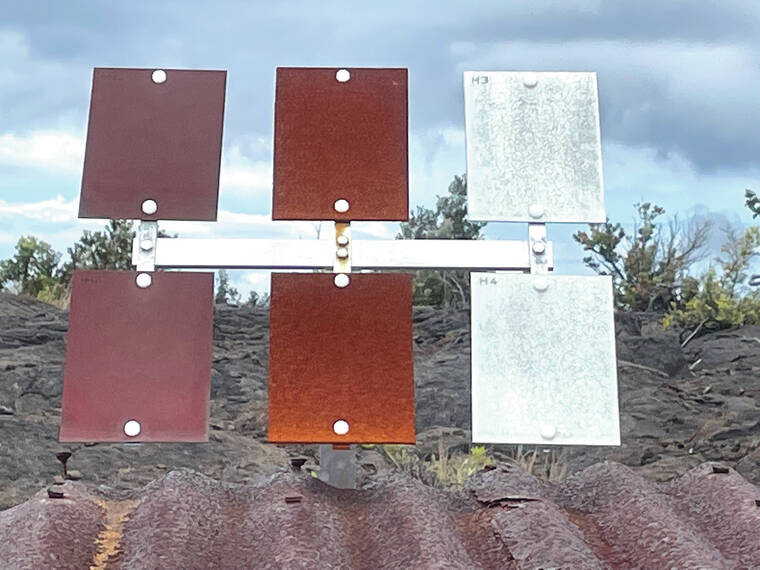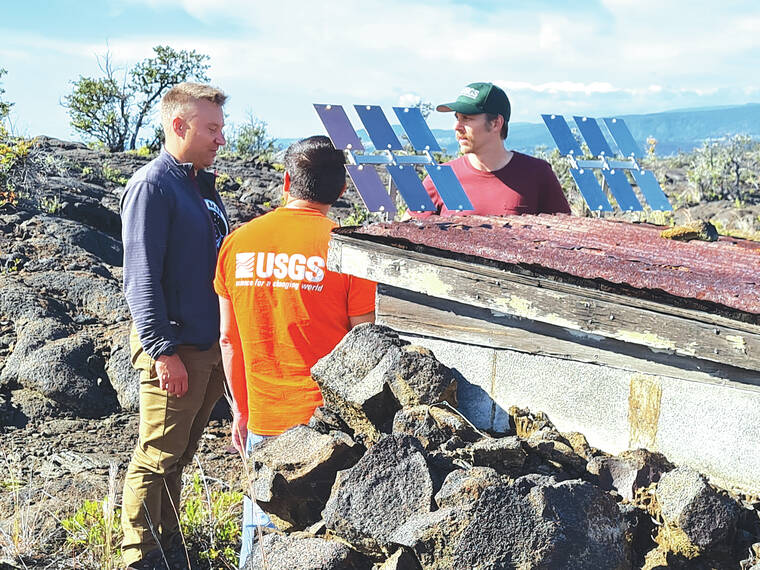Volcano Watch: Quantifying corrosion downwind of Kilauea


In December 2022, a team of scientists from Aotearoa, New Zealand teamed up with scientists from the USGS Hawaiian Volcano Observatory (HVO) to carry out a small pilot study of atmospheric corrosion rates on the island of Hawaii. The purpose was to expand our knowledge base of how metal corrodes in different environments — specifically metal that is often used as building and roofing material.
In New Zealand we have carried out studies in extreme coastal environments (exposed to high rates of marine aerosol deposition) and in geothermal environments (exposed to hydrogen sulfide and minor amounts of sulfur dioxide), but we do not have access to sites exposed to moderate to high concentrations of sulfur dioxide. This is of particular interest for future volcanic eruptions in New Zealand, such as an eruption in the Auckland Volcanic Field, which is overlain by the city of Auckland. Study findings will also have applicability to other parts of the world, including in Hawaii, downwind of volcanic eruptions.
ADVERTISING
With permission from the Hawaii Volcanoes National Park and landowners, we mounted specially prepared rectangular metal samples (150 by 100 mm; just under 6 by 4 inches), called coupons, of mild steel, copper, zinc, and hot-dip galvanized (HDG) zinc coating, at three locations downwind and one upwind of Kaluapele, Kilauea’s summit crater. Mild steel is the base material for many steel structures and its corrosion rate is fundamental to estimating the service life of such structures. Copper is widely used in power distribution systems and HDG is used to protect steel structures, claddings, and fastenings.
A year later, the coupons were retrieved and returned to the Building Research Association of New Zealand (BRANZ)’s corrosion laboratory for analysis. Corrosion products were removed and then the cleaned coupons weighed to determine their mass losses over the year they were exposed. These results were used to calculate first-year corrosion rates. These can be used to assess the resistance of these materials to atmospheric corrosion under the influence of volcanic emissions. We also classified the corrosivity of each site according to the accepted international classification scheme (ISO 9223).
Our results indicate that all sites are classified as ‘Medium’ over the study period.
This is similar to inland coastal regions of New Zealand with moderate exposure to wind-driven marine aerosol and geothermal regions not immediately adjacent to geothermal features such as hot springs and fumaroles.
We note that our study period coincided with a period of mostly low SO2 emissions from Kilauea and thus we likely underestimate corrosivity at other times with higher emissions.
We were particularly interested in the relatively high corrosion rates of copper and zinc at Site 1, which was the closest to Kilauea’s summit vent but upwind relative to the prevailing trade wind field. Our previous work in the Rotorua geothermal field has suggested that copper, in particular, is highly susceptible to relatively low concentrations of hydrogen sulfide and sulfur dioxide. Potential explanations include the presence of hydrogen sulfide at Site 1, and the influence of other environmental factors such as the higher rainfall at this site.
We thank HVO and the landowners who hosted the corrosion test rigs as well as everyone who has been supportive of and interested in this study.
We will continue to share new findings and insights, and we welcome expressions of interest from any parties interested in progressing this work. This could include areas such as understanding the variability of atmospheric corrosivity across the island of Hawaii, assessing corrosivity rates during heightened activity from Kilauea, and assessing the durability of materials that are commonly used for buildings and construction on the island.
Volcano activity updates
Kilauea is not erupting. Its USGS Volcano Alert level is ADVISORY.
Over the past week, earthquake rates beneath Kilauea summit and upper-to-middle East Rift Zone were about double that of the previous week. About 10 earthquakes were located beneath the summit, and about 70 were located in the upper-to-middle East Rift Zone. Ground deformation rates continue to show slow inflation at the summit and near the September 15-20 middle East Rift Zone eruption site. Future intrusive episodes and eruptions could occur with continued magma supply.
Mauna Loa is not erupting. Its USGS Volcano Alert Level is at NORMAL.
Three earthquakes were reported felt in the Hawaiian Islands during the past week: a M1.7 earthquake 13 km (8 mi) ENE of Honaunau-Napoopoo at 9 km (6 mi) depth on Nov. 15 at 9:26 p.m. HST, a M4.1 earthquake 19 km (11 mi) SE of Pahala at 33 km (20 mi) depth on Nov. 14 at 12:42 p.m. HST, and a M3.2 earthquake 0 km (0 mi) N of Volcano at 28 km (17 mi) depth on Nov. 14 at 6:09 a.m. HST.
HVO continues to closely monitor Kilauea and Mauna Loa.
Please visit HVO’s website for past Volcano Watch articles, Kilauea and Mauna Loa updates, volcano photos, maps, recent earthquake information, and more. Email questions to askHVO@usgs.gov.






